Heavy Metals Enrichment Associated with Water-Level Fluctuations in the Riparian Soils of the Xiaowan Reservoir, Lancang River
Abstract
:1. Introduction
2. Materials and Methods
2.1. Study Area
2.2. The Hydrologic Regime of XWR
2.3. Soil Sampling and Chemical Analysis
2.4. Contamination Evaluation
2.5. Statistical Analysis
3. Results
3.1. Distribution of Heavy Metal Concentrations in the Soil of the Riparian Zone
3.2. Trace Metal Enrichment of Riparian Soils and Metal Contamination Assessment
4. Discussion
4.1. Lateral and Longitudinal Distribution of Heavy Metal Concentrations in the Riparian Soils
4.2. Influence of the Changed Hydrologic Processes on Heavy Metals Accumulation in Riparian Soils
5. Conclusions
Supplementary Materials
Author Contributions
Funding
Acknowledgments
Conflicts of Interest
References
- Ciszewski, D.; Grygar, T.M. A Review of Flood-Related Storage and Remobilization of Heavy Metal Pollutants in River Systems. Water Air Soil Pollut. 2016, 227, 239. [Google Scholar] [CrossRef] [PubMed] [Green Version]
- Li, X.L.; Shen, H.L.; Zhao, Y.J.; Cao, W.X.; Hu, C.W.; Chen, S. Distribution and Potential Ecological Risk of Heavy Metals in Water, Sediments, and Aquatic Macrophytes: A Case Study of the Junction of Four Rivers in Linyi City, China. Int. J. Environ. Res. Public Health 2019, 16, 2861. [Google Scholar] [CrossRef] [PubMed] [Green Version]
- Shim, M.J.; Yang, Y.M.; Oh, D.Y.; Lee, S.H.; Yoon, Y.Y. Spatial distribution of heavy metal accumulation in the sediments after dam construction. Environ. Monit. Assess. 2015, 187, 733. [Google Scholar] [CrossRef] [PubMed]
- Zhang, W.; Long, J.H.; Zhang, X.; Shen, W.; Wei, Z. Pollution and Ecological Risk Evaluation of Heavy Metals in the Soil and Sediment around the HTM Tailings Pond, Northeastern China. Int. J. Environ. Res. Public Health 2020, 17, 7072. [Google Scholar] [CrossRef] [PubMed]
- Sayadi, M.H.; Rezaei, M.R.; Rezaei, A. Sediment Toxicity and Ecological Risk of Trace Metals from Streams Surrounding a Municipal Solid Waste Landfill. Bull. Environ. Contam. Toxicol. 2015, 94, 559–563. [Google Scholar] [CrossRef] [PubMed]
- Santos-Frances, F.; Martinez-Grana, A.; Zarza, C.A.; Sanchez, G.A.; Roji, P.A. Spatial Distribution of Heavy Metals and the Environmental Quality of Soil in the Northern Plateau of Spain by Geostatistical Methods. Int. J. Environ. Res. Public Health 2017, 14, 568. [Google Scholar] [CrossRef] [PubMed]
- Duan, X.W.; Zhang, G.L.; Rong, L.; Fang, H.Y.; He, B.Y.; Feng, D.T. Spatial distribution and environmental factors of catchment-scale soil heavy metal contamination in the dry-hot valley of Upper Red River in southwestern China. Catena 2015, 135, 59–69. [Google Scholar] [CrossRef]
- Wang, C.; Liu, S.L.; Zhao, Q.H.; Deng, L.; Dong, S.K. Spatial variation and contamination assessment of heavy metals in sediments in the Manwan Reservoir, Lancang River. Ecotoxicol. Environ. Saf. 2012, 82, 32–39. [Google Scholar] [CrossRef]
- Ye, C.; Li, S.Y.; Zhang, Y.L.; Zhang, Q.F. Assessing soil heavy metal pollution in the water-level-fluctuation zone of the Three Gorges Reservoir, China. J. Haz. Mat. 2011, 191, 366–372. [Google Scholar] [CrossRef]
- Zhang, L.P.; Ye, X.; Feng, H.; Jing, Y.H.; Ouyang, T.; Yu, X.T.; Liang, R.Y.; Gao, C.T.; Chen, W.Q. Heavy metal contamination in western Xiamen Bay sediments and its vicinity, China. Mar. Pollut. Bull. 2007, 54, 974–982. [Google Scholar] [CrossRef]
- Tang, Q.; Bao, Y.H.; He, X.B.; Zhou, H.D.; Cao, Z.J.; Gao, P.; Zhong, R.H. Sedimentation and associated trace metal enrichment in the riparian zone of the Three Gorges Reservoir, China. Sci. Total Environ. 2014, 479, 258–266. [Google Scholar] [CrossRef] [PubMed]
- Ye, C.; Butler, O.M.; Du, M.; Liu, W.Z.; Zhang, Q.F. Spatio-temporal dynamics, drivers and potential sources of heavy metal pollution in riparian soils along a 600 kilometre stream gradient in Central China. Sci. Total Environ. 2019, 651, 1935–1945. [Google Scholar] [CrossRef] [PubMed]
- Liu, S.L.; Wang, C.; Yang, J.J.; Zhao, Q.H. Assessing the heavy metal contamination of soils in the water-level fluctuation zone upstream and downstream of the Manwan Dam, Lancang River. J. Soil. Sediment. 2014, 14, 1147–1157. [Google Scholar] [CrossRef] [Green Version]
- Pringle, C. What is hydrologic connectivity and why is it ecologically important? Hydrol. Process. 2003, 17, 2685–2689. [Google Scholar] [CrossRef]
- Liu, L.; Li, F.S.; Xiong, D.Q.; Song, C.Y. Heavy metal contamination and their distribution in different size fractions of the surficial sediment of Haihe River, China. Environ. Geol. 2006, 50, 431–438. [Google Scholar] [CrossRef]
- Zhang, M.Y.; Cui, L.J.; Sheng, L.X.; Wang, Y.F. Distribution and enrichment of heavy metals among sediments, water body and plants in Hengshuihu Wetland of Northern China. Ecol. Eng. 2009, 35, 563–569. [Google Scholar] [CrossRef]
- Fu, K.D.; Wang, C.; Su, B.; Li, D.X.; Yang, W.H.; Li, M.Y.; Lu, J.X.; Li, D. Distribution and Pollution Assessment of Heavy Metals in Sand Sediment of Reservoir along the Middle and Lower Reaches of Lancang River. Ecol. Econ. 2016, 32, 163–168+191. [Google Scholar]
- Mays, P.A.; Edwards, G.S. Comparison of heavy metal accumulation in a natural wetland and constructed wetlands receiving acid mine drainage. Ecol. Eng. 2001, 16, 487–500. [Google Scholar] [CrossRef]
- Zhang, W.G.; Feng, H.; Chang, J.N.; Qu, J.G.; Xie, H.X.; Yu, L.Z. Heavy metal contamination in surface sediments of Yangtze River intertidal zone: An assessment from different indexes. Environ. Pollut. 2009, 157, 1533–1543. [Google Scholar] [CrossRef]
- Bao, Y.H.; Gao, P.; He, X.B. The water-level fluctuation zone of Three Gorges Reservoir A unique geomorphological unit. Earth Sci. Rev. 2015, 150, 14–24. [Google Scholar] [CrossRef]
- Wantzen, K.M.; Rothhaupt, K.O.; Mortl, M.; Cantonati, M.; Laszlo, G.T.; Fischer, P. Ecological effects of water-level fluctuations in lakes: An urgent issue. Hydrobiologia 2008, 613, 1–4. [Google Scholar] [CrossRef]
- Tang, Q.; Fu, B.J.; Collins, A.L.; Wen, A.B.; He, X.B.; Bao, Y.H. Developing a sustainable strategy to conserve reservoir marginal landscapes. Natl. Sci. Rev. 2018, 5, 10–14. [Google Scholar] [CrossRef] [Green Version]
- Evtimova, V.V.; Donohue, I. Water-level fluctuations regulate the structure and functioning of natural lakes. Freshw. Biol. 2016, 61, 251–264. [Google Scholar] [CrossRef]
- Hofmann, H.; Lorke, A.; Peeters, F. Temporal scales of water-level fluctuations in lakes and their ecological implications. Hydrobiologia 2008, 613, 85–96. [Google Scholar] [CrossRef] [Green Version]
- Leira, M.; Cantonati, M. Effects of water-level fluctuations on lakes: An annotated bibliography. Hydrobiologia 2008, 613, 171–184. [Google Scholar] [CrossRef]
- Logez, M.; Roy, R.; Tissot, L.; Argillier, C. Effects of water-level fluctuations on the environmental characteristics and fish-environment relationships in the littoral zone of a reservoir. Fund. Appl. Limnol. 2016, 189, 37–49. [Google Scholar] [CrossRef]
- Cheng, F.Y.; Liu, S.L.; Yin, Y.J.; Zhang, Y.Q.; Zhao, Q.H.; Dong, S.K. Identifying trace metal distribution and occurrence in sediments, inundated soils, and non-flooded soils of a reservoir catchment using Self-Organizing Maps, an artificial neural network method. Environ. Sci. Pollut. Res. 2017, 24, 19992–20004. [Google Scholar] [CrossRef] [PubMed]
- Ye, C.; Li, S.Y.; Zhang, Y.L.; Tong, X.Z.; Zhang, Q.F. Assessing heavy metal pollution in the water level fluctuation zone of China’s Three Gorges Reservoir using geochemical and soil microbial approaches. Environ. Monit. Assess. 2013, 185, 231–240. [Google Scholar] [CrossRef]
- Saha, J.K.S.R.; Coumar, M.V.; Dotaniya, M.L.; Kundu, S.; Patra, A.K. Assessment of heavy metals contamination in soil. In Soil Pollution—An Emerging Threat to Agriculture, in Environmental Chemistry for a Sustainable World; Lichtfouse, E., Schwarzbauer, J., Robert, D., Eds.; Springer: Singapore, 2017. [Google Scholar]
- Wrzesinski, D.; Ptak, M. Water level changes in Polish lakes during 1976–2010. J. Geogr. Sci. 2016, 26, 83–101. [Google Scholar] [CrossRef] [Green Version]
- Zhao, Q.H.; Liu, S.L.; Deng, L.; Dong, L.; Dong, S.K.; Wang, C. Soil degradation associated with water-level fluctuations in the Manwan Reservoir, Lancang River Basin. Catena 2014, 113, 226–235. [Google Scholar] [CrossRef]
- Furey, P.C.; Nordin, R.N.; Mazumder, A. Water level drawdown affects physical and biogeochemical properties of littoral sediments of a reservoir and a natural lake. Lake Reserv. Manag. 2004, 20, 280–295. [Google Scholar] [CrossRef]
- Gregory, S.V.; Swanson, F.J.; Mckee, W.A.; Cummins, K.W. An Ecosystem Perspective of Riparian Zones. Bioscience 1991, 41, 540–551. [Google Scholar] [CrossRef]
- Hupp, C.R.; Osterkamp, W.R. Riparian vegetation and fluvial geomorphic processes. Geomorphology 1996, 14, 277–295. [Google Scholar] [CrossRef]
- Naiman, R.J.; Decamps, H. The ecology of interfaces: Riparian zones. Annu. Rev. Ecol. Syst. 1997, 28, 621–658. [Google Scholar] [CrossRef] [Green Version]
- Brauns, M.; Garcia, X.F.; Pusch, M.T. Potential effects of water-level fluctuations on littoral invertebrates in lowland lakes. Hydrobiologia 2008, 613, 5–12. [Google Scholar] [CrossRef]
- Peintinger, M.; Prati, D.; Winkler, E. Water level fluctuations and dynamics of amphibious plants at Lake Constance: Long-term study and simulation. Perspect. Plant Ecol. 2007, 8, 179–196. [Google Scholar] [CrossRef]
- Coops, H.; Beklioglu, M.; Crisman, T.L. The role of water-level fluctuations in shallow lake ecosystems—Workshop conclusions. Hydrobiologia 2003, 506, 23–27. [Google Scholar] [CrossRef]
- Nilsson, C.; Reidy, C.A.; Dynesius, M.; Revenga, C. Fragmentation and flow regulation of the world’s large river systems. Science 2005, 308, 405–408. [Google Scholar] [CrossRef] [Green Version]
- Zhao, Q.H.; Liu, S.L.; Deng, L.; Yang, Z.F.; Dong, S.K.; Wang, C.; Zhang, Z.L. Spatio-temporal variation of heavy metals in fresh water after dam construction: A case study of the Manwan Reservoir, Lancang River. Environ. Monit. Assess. 2012, 184, 4253–4266. [Google Scholar] [CrossRef]
- Xu, Y.Y.; Zhang, M.; Wang, L.; Kong, L.H.; Cai, Q.H. Changes in water types under the regulated mode of water level in Three Gorges Reservoir, China. Quatern. Int. 2011, 244, 272–279. [Google Scholar] [CrossRef]
- Chen, J.G.; Wang, J.F.; Guo, J.Y.; Yu, J.; Zeng, Y.; Yang, H.Q.; Zhang, R.Y. Eco-environment of reservoirs in China: Characteristics and research prospects. Prog. Phys. Geog. 2018, 42, 185–201. [Google Scholar] [CrossRef]
- Shao, M.L.; Xie, Z.C.; Han, X.Q.; Cao, M.; Cai, Q.H. Macroinvertebrate community structure in Three-Gorges Reservoir, China. Int. Rev. Hydrobiol. 2008, 93, 175–187. [Google Scholar] [CrossRef]
- Riis, T.; Hawes, I. Relationships between water level fluctuations and vegetation diversity in shallow water of New Zealand lakes. Aquat. Bot. 2002, 74, 133–148. [Google Scholar] [CrossRef]
- Wang, W.D.; Yin, C.Q. The boundary filtration effect of reed-dominated ecotones under water level fluctuations. Wetl. Ecol. Manag. 2008, 16, 65–76. [Google Scholar] [CrossRef]
- Song, J.Y.; Fu, K.D.; Su, B.; Huang, Q.S.; Huang, J.C.; Zhang, J.L. Spatial distribution of heavy metal concentrations and pollution assessment in the bed loads of the Lancang River System. Acta Geogr. Sin. 2013, 68, 389–397. [Google Scholar]
- Zhang, J.L.; Fu, K.D.; Wang, B.; Chen, L.Q.; Song, J.Y.; Su, B. Assessment of heavy metal pollution of bed sediment in the Lancang River. Prog. Geogr. 2014, 33, 1136–1144. [Google Scholar]
- Fu, K.D.; Su, B.; He, D.M.; Lu, X.X.; Song, J.Y.; Huang, J.C. Pollution assessment of heavy metals along the Mekong River and dam effects. J. Geogr. Sci. 2012, 22, 874–884. [Google Scholar] [CrossRef]
- Wu, X.D.; He, D.M.; Yang, G.J.; Ye, L.L.; Zhu, C.L.; Jia, H.F.; Hu, J.M. Seasonal variability of water quality and metazooplankton community structure in Xiaowan Reservoir of the upper Mekong River. J. Limnol. 2014, 73, 167–176. [Google Scholar] [CrossRef] [Green Version]
- Allen, S.E. Chemical Analysis of Ecological Materials; Blackwell: Oxford, UK, 1989. [Google Scholar]
- Wei, F. Background Values of Elements in Soils of China; Environmental Science Press: Beijing, China, 1990; Volume 501. [Google Scholar]
- Ghrefat, H.A.; Abu-Rukah, Y.; Rosen, M.A. Application of geoaccumulation index and enrichment factor for assessing metal contamination in the sediments of Kafrain Dam, Jordan. Environ. Monit. Assess. 2011, 178, 95–109. [Google Scholar] [CrossRef]
- Hakanson, L. An ecological risk index for aquatic pollution control. A sedimentological approach. Water Res. 1980, 14, 975–1001. [Google Scholar] [CrossRef]
- Tang, Q.; Bao, Y.H.; He, X.B.; Wen, A.B. Heavy metal enrichment in the riparian sediments and soils of the Three Gorges Reservoir, China. Proc. Int. Assoc. Hydrol. Sci. 2015, 367, 244–250. [Google Scholar] [CrossRef]
- Wang, Y.C.; Lei, B.; Yang, S.M.; Zhang, S. Concentrations and pollution assessment of soil heavy metals at different water-level altitudes in the draw-down areas of the Three Gorges Reservoir. Environ. Sci. Pollut. Res. 2012, 33, 612–617. [Google Scholar]
- Song, J.Y.; Duan, X.W.; Han, X.; Li, Y.M.; Li, Y.M.; He, D.M. The accumulation and redistribution of heavy metals in the water-level fluctuation zone of the Nuozhadu Reservoir, Upper Mekong. Catena 2019, 172, 335–344. [Google Scholar] [CrossRef]
- Chu, L.M.; Chang, C.; Xie, Z.Q.; Xiong, G.M. Effect of impounding of the Three-Gorges Reservoir on soil heavy metals in its hydro fluctuation belt. Acta Pedol. Sin. 2011, 48, 192–196. [Google Scholar]
- Pei, S.X.; Jian, Z.J.; Guo, Q.S.; Ma, F.Q.; Qin, A.L.; Zhao, Y.J.; Xin, X.B.; Xiao, W.F. Temporal and spatial variation and risk assessment of soil heavy metal concentrations for water-level-fluctuating zones of the Three Gorges Reservoir. J. Soil Sediment. 2018, 18, 2924–2934. [Google Scholar] [CrossRef]
- Wang, X.Y.; Fu, W.L.; Xie, F.; Pu, P.; Peng, J.T. The distribution characteristic of soil heavy metals and their influencing factors in water-level fluctuating zones of the Three Gorges reservoir area. Res. Soil Water Conserv. 2010, 17, 267–270. [Google Scholar]
- Kuusisto-Hjort, P.; Hjort, J. Land use impacts on trace metal concentrations of suburban stream sediments in the Helsinki region, Finland. Sci. Total Environ. 2013, 456, 222–230. [Google Scholar] [CrossRef] [PubMed]
- Marttila, H.; Saarinen, T.; Celebi, A.; Klove, B. Transport of particle-associated elements in two agriculture-dominated boreal river systems. Sci. Total Environ. 2013, 461, 693–705. [Google Scholar] [CrossRef]
- Cheng, X.F.; Danek, T.; Drozdova, J.; Huang, Q.R.; Qi, W.F.; Zou, L.L.; Yang, S.R.; Zhao, X.L.; Xiang, Y.G. Soil heavy metal pollution and risk assessment associated with the Zn-Pb mining region in Yunnan, Southwest China. Environ. Monit. Assess. 2018, 190, 194. [Google Scholar] [CrossRef]
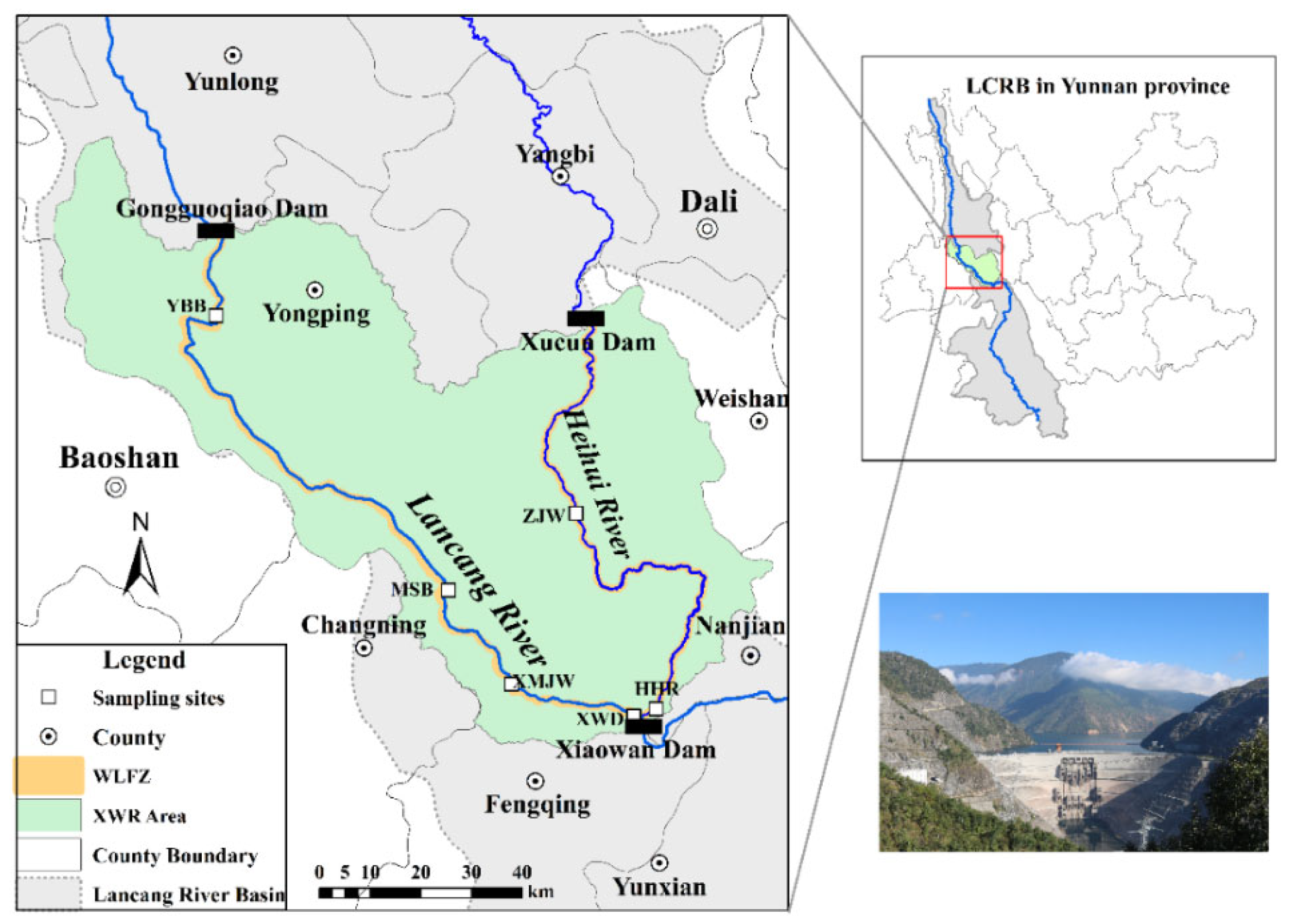

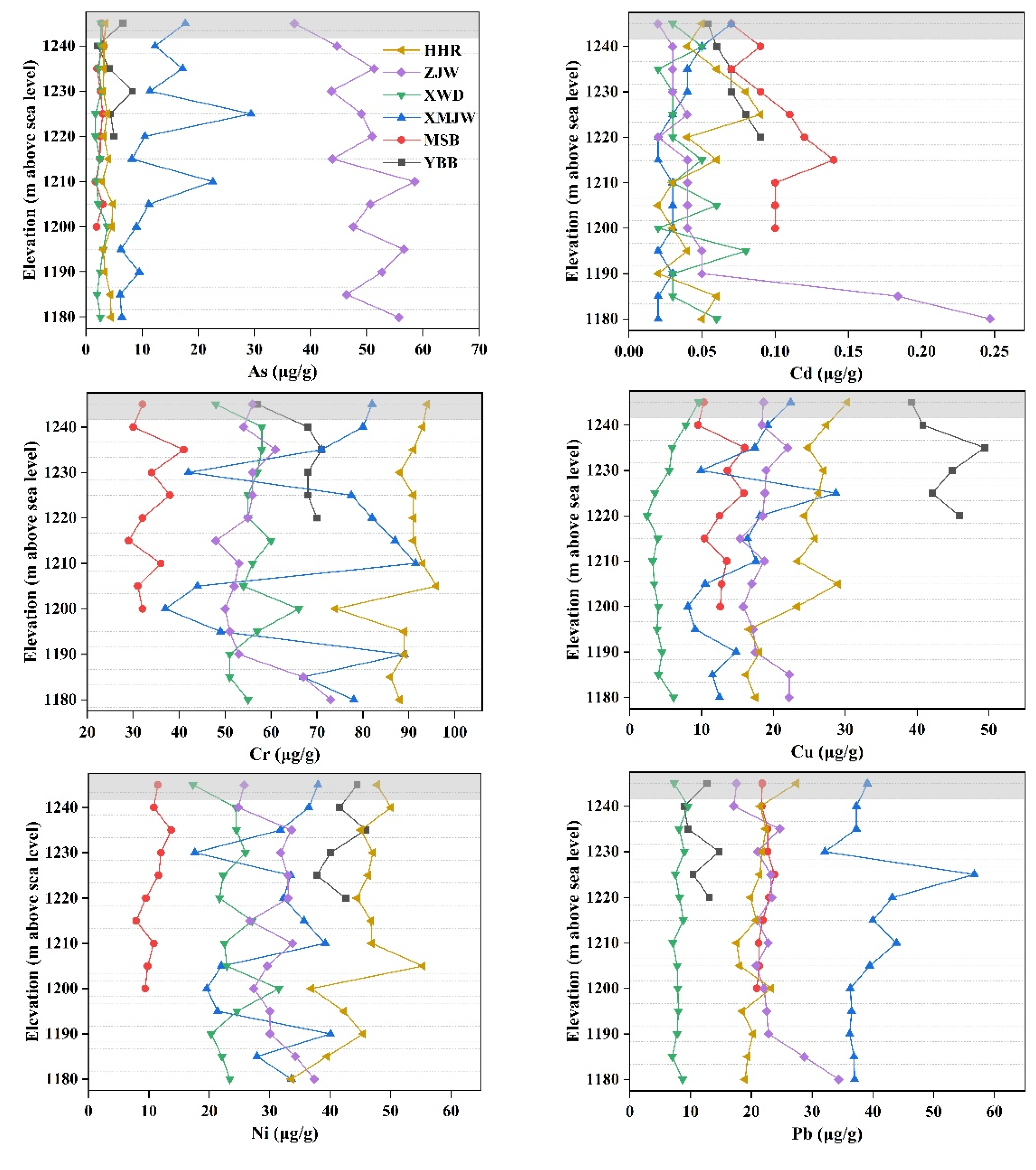

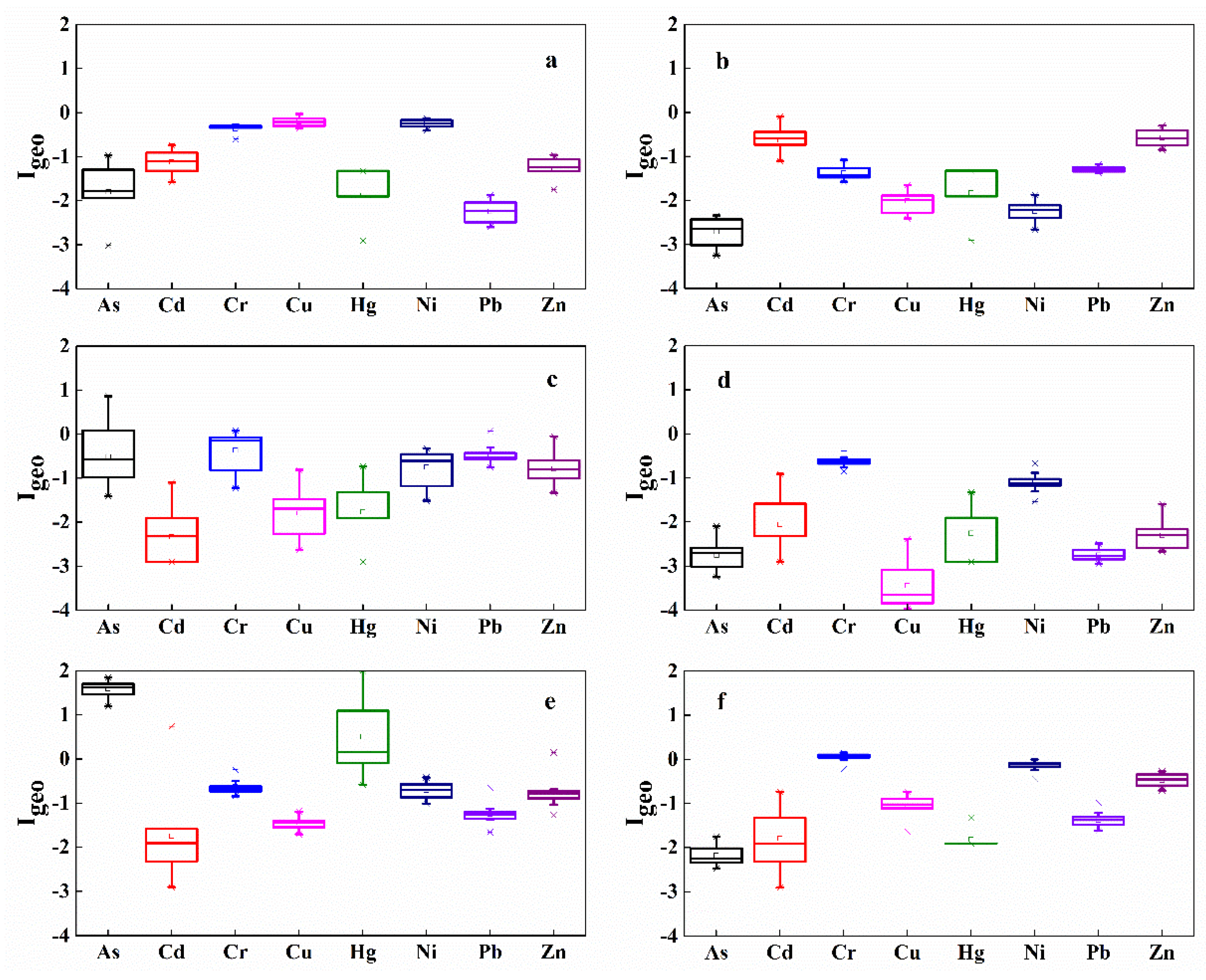
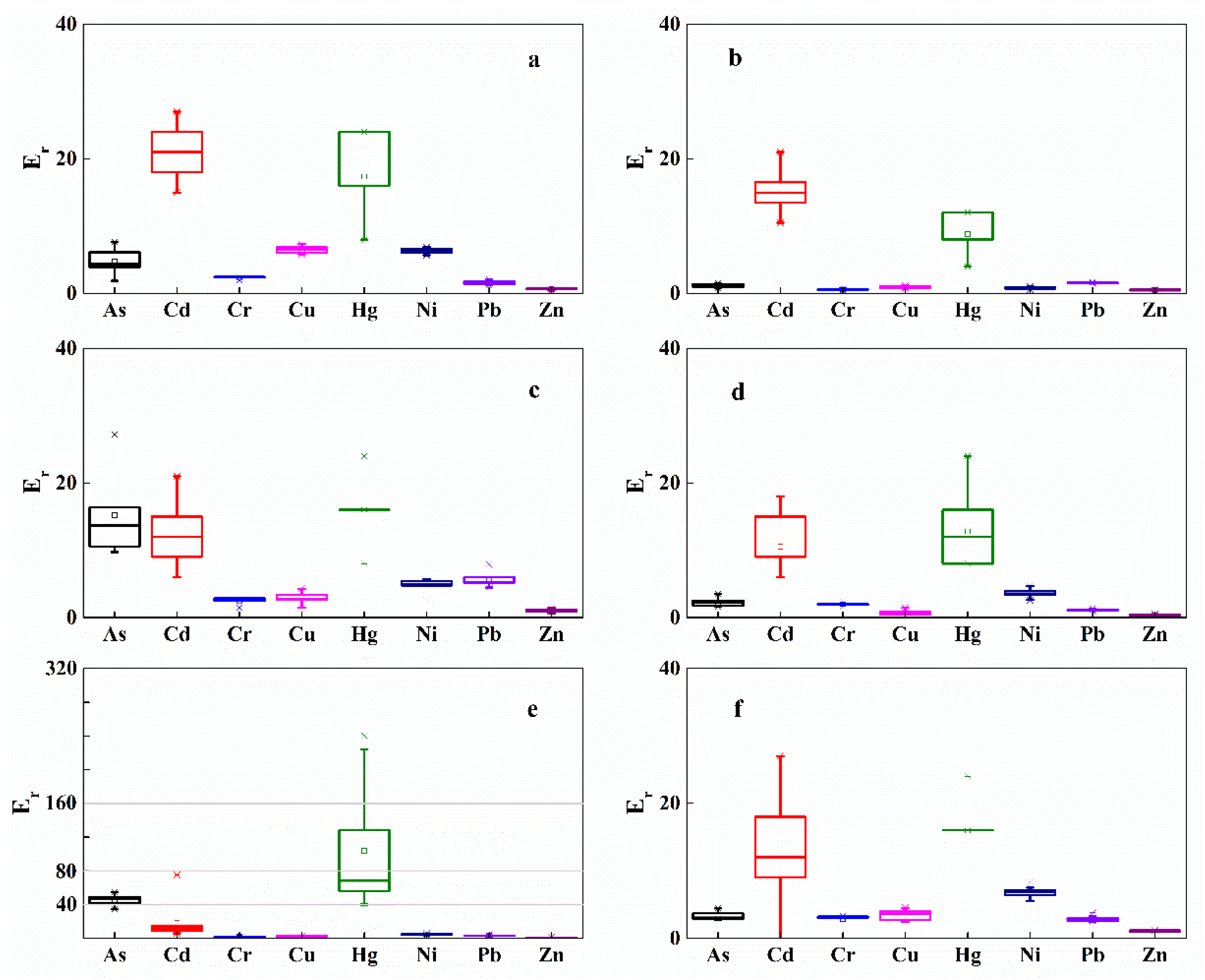
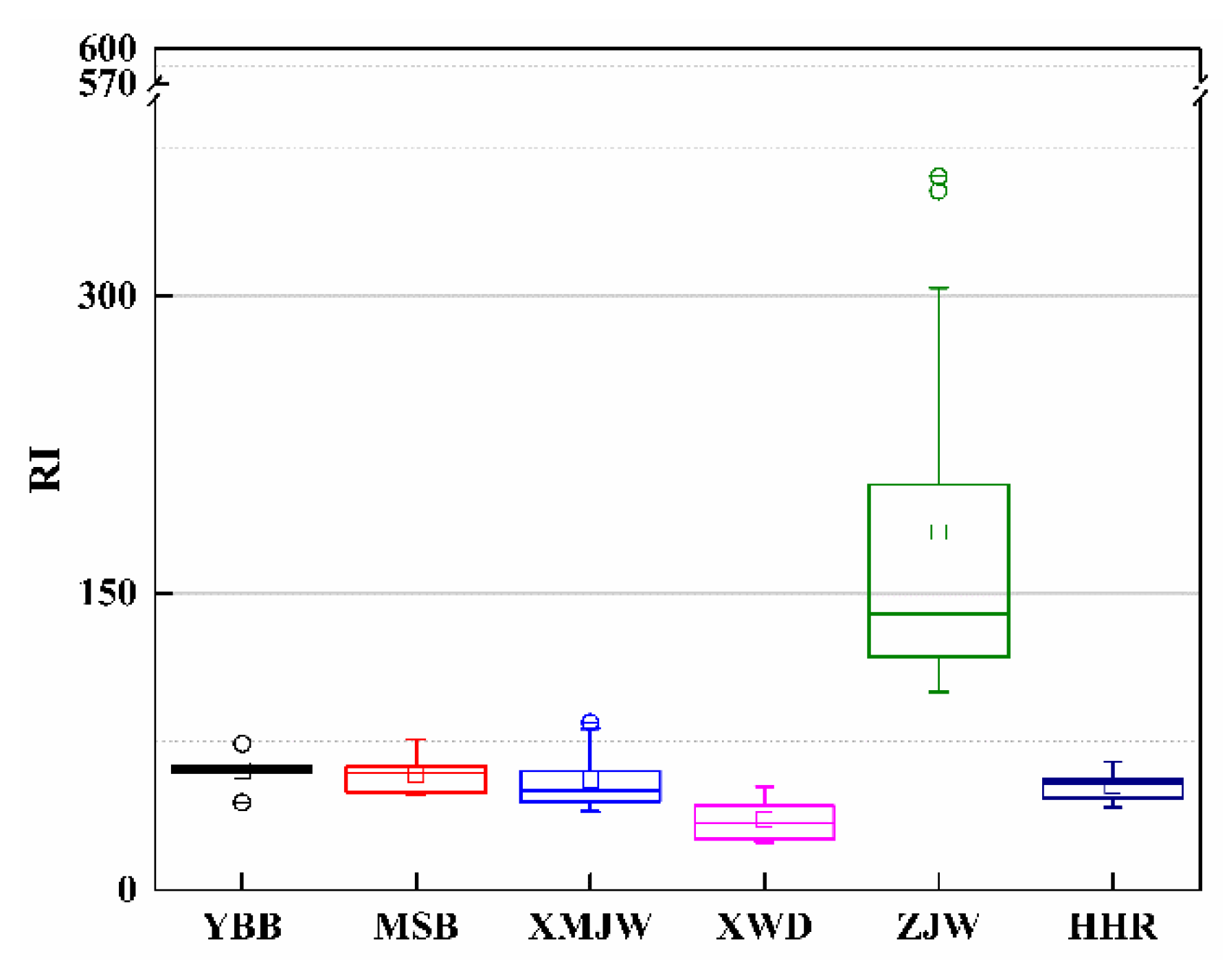
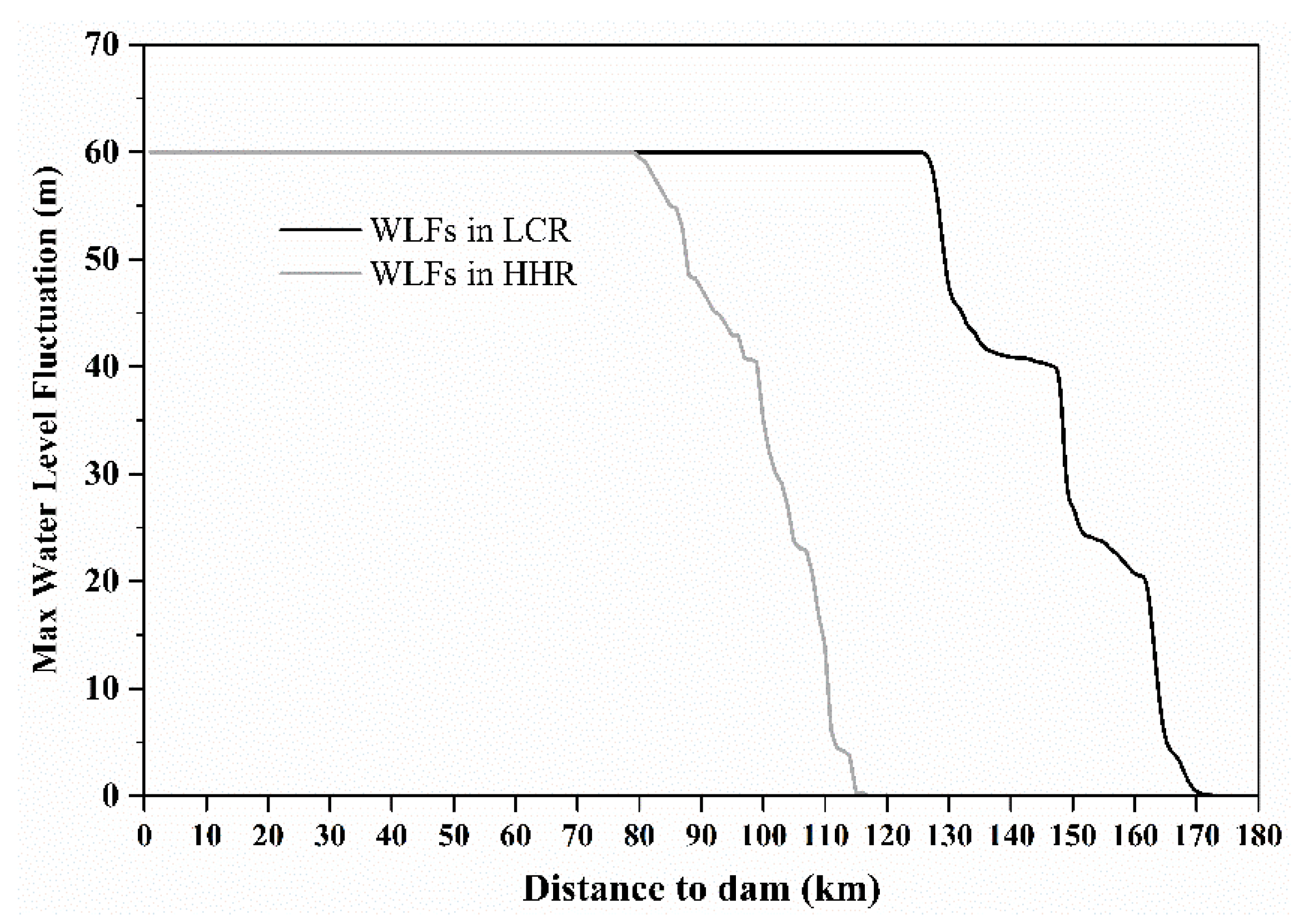
| Element | As | Cd | Cr | Cu | Hg | Ni | Pb | Zn |
|---|---|---|---|---|---|---|---|---|
| Background value (mg/kg) | 10.8 | 0.1 | 57.6 | 33.6 | 0.05 | 33.4 | 36.0 | 80.5 |
| Toxicity coefficient (Tri) | 10 | 30 | 2 | 5 | 40 | 5 | 5 | 1 |
| Igeo Value | Igeo Class | Contamination Status | Eri Value | RI Value | Ecological Risk Level |
|---|---|---|---|---|---|
| ≤0 | 0 | UP | ≤40 | ≤150 | Low |
| 0–1 | 1 | UP-MP | 40–80 | 150–300 | Moderate |
| 1–2 | 2 | MP | 80–160 | 300–600 | High |
| 2–3 | 3 | MP-SP | 160–320 | >600 | Very high |
| 3–4 | 4 | SP | >320 | Extremely High | |
| 4–5 | 5 | SP-EP | |||
| >5 | 6 | EP |
| As | Cd | Cr | Cu | Hg | Ni | Pb | Zn | |
|---|---|---|---|---|---|---|---|---|
| As | 1 | |||||||
| Cd | −0.22 | 1 | ||||||
| Cr | 0.18 | −0.24 * | 1 | |||||
| Cu | 0.43 ** | 0.21 | 0.56 ** | 1 | ||||
| Hg | 0.66 ** | 0.02 | −0.05 | 0.27 * | 1 | |||
| Ni | 0.33 ** | −0.095 | 0.91 ** | 0.77 ** | 0.14 | 1 | ||
| Pb | 0.58 ** | -.110 | 0.16 | 0.232* | 0.24 * | 0.11 | 1 | |
| Zn | 0.24* | 0.36 ** | 0.33 ** | 0.60 ** | 0.20 | 0.36 ** | 0.57 ** | 1 |
Publisher’s Note: MDPI stays neutral with regard to jurisdictional claims in published maps and institutional affiliations. |
© 2022 by the authors. Licensee MDPI, Basel, Switzerland. This article is an open access article distributed under the terms and conditions of the Creative Commons Attribution (CC BY) license (https://creativecommons.org/licenses/by/4.0/).
Share and Cite
Zhong, R.; Zhang, Y.; Duan, X.; Wang, F.; Anjum, R. Heavy Metals Enrichment Associated with Water-Level Fluctuations in the Riparian Soils of the Xiaowan Reservoir, Lancang River. Int. J. Environ. Res. Public Health 2022, 19, 12902. https://doi.org/10.3390/ijerph191912902
Zhong R, Zhang Y, Duan X, Wang F, Anjum R. Heavy Metals Enrichment Associated with Water-Level Fluctuations in the Riparian Soils of the Xiaowan Reservoir, Lancang River. International Journal of Environmental Research and Public Health. 2022; 19(19):12902. https://doi.org/10.3390/ijerph191912902
Chicago/Turabian StyleZhong, Ronghua, Yun Zhang, Xingwu Duan, Fei Wang, and Raheel Anjum. 2022. "Heavy Metals Enrichment Associated with Water-Level Fluctuations in the Riparian Soils of the Xiaowan Reservoir, Lancang River" International Journal of Environmental Research and Public Health 19, no. 19: 12902. https://doi.org/10.3390/ijerph191912902
APA StyleZhong, R., Zhang, Y., Duan, X., Wang, F., & Anjum, R. (2022). Heavy Metals Enrichment Associated with Water-Level Fluctuations in the Riparian Soils of the Xiaowan Reservoir, Lancang River. International Journal of Environmental Research and Public Health, 19(19), 12902. https://doi.org/10.3390/ijerph191912902







